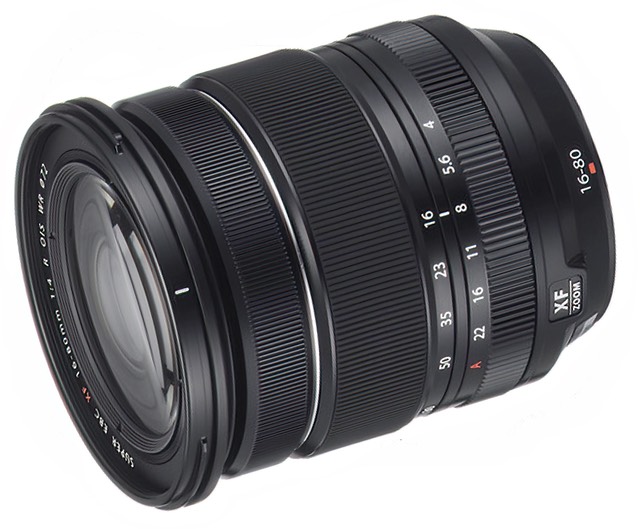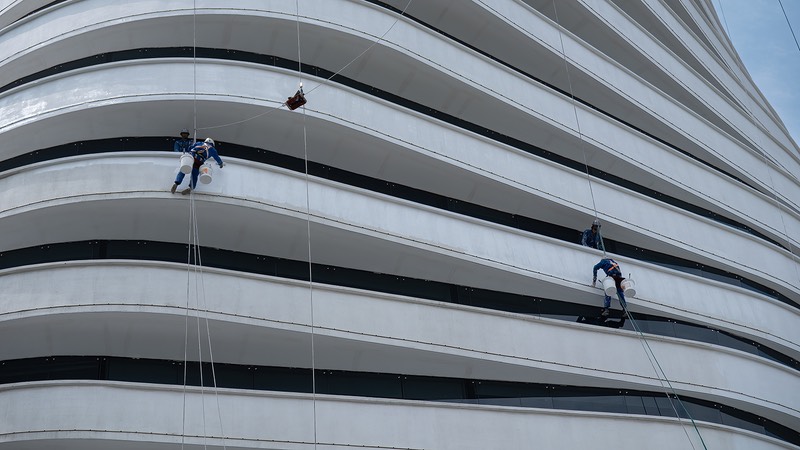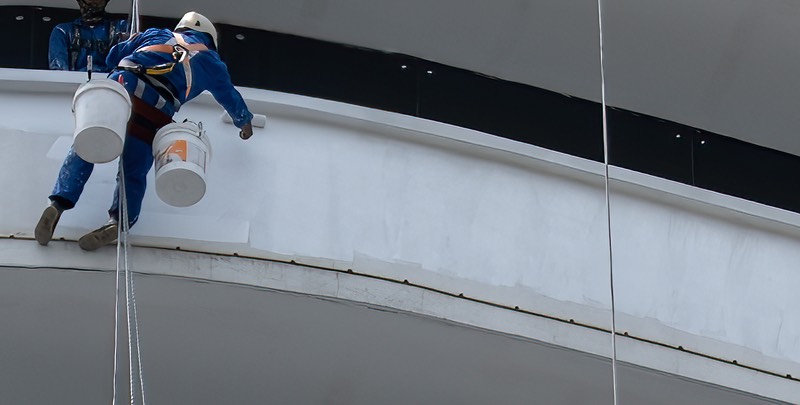
What is It?
Fujifilm has produced a range of mid-range zooms (15-45mm f/3.5-5.6, 16-50mm f/3.5-5.6, 16-55mm f/2.8, and 18-55mm f/2.8-4) in addition to this one. Each of the aforementioned lenses tend towards a very specific set of design choices. The 16-80mm f/4 lens being reviewed here is probably a mid-range zoom that is somewhere dead center between convenience lens and critically professional.
The focal range of the lens being reviewed is equivalent to 24-120mm on full frame cameras, and 24-120mm (as well as 24-105mm) f/4 has been a well-proven formula for sales success over the years. The two things that generate the most excitement to the potential buyer are f/4 and 120mm. The former keeps the lens smaller, lighter, and less pricey than the traditional f/2.8 mid-range zoom, while the latter gives you more reach, meaning you change lenses less often.
Optically, the 16-80mm f/4 R OIS WR leans a bit more on aspherical elements than more elements, with a 16 element in 12 group design, where three of those are aspherical. The front seven elements move out together when the lens is zoomed. The one ED element is used as the OIS element. It's well in back of aperture diaphragm, which I believe leads to a bit of busy bokeh at times. That said, Fujifilm claims 6 stops CIPA capability with the lens.
The lens itself is relatively compact, at least at the 16mm focal length, coming in at 3.5" (89mm) long. At 120mm, however, the front lens barrel extends out another 45mm. With the supplied petal-shape lens hood on, at 120mm the lens is nearly 7" in total length from the camera body. Unlike many barrel extensions, my samples had no wobble.
Weight is a reasonable 15.5 ounces (440g), given the focal range and aperture. Meanwhile, build quality includes dust and weather sealing at 10 points, and Fujifilm claims "mounting on weather resistant cameras...allows you to shoot in light rain...with peace of mind."
Up front there are threads for 72mm filters. Internally, there are nine rounded aperture blades. Externally, we have a clicked aperture ring (up to f/22, plus an A setting), but no other controls than the focus ring at the very front of the non-extending portion of the lens (focus by wire). Yes, the lens has OIS stabilization (up to 6 stops CIPA), but this is controlled by camera menu, not by a switch on the lens.
Minimum focus distance is a short 14" (0.35m), and this produces a maximum magnification ratio of 1:4. Not quite into the macro range, but fairly good for a mid-range zoom. Fujifilm also claims very little focal length breathing. I found that to be true for mid-to-long-range focus, but there's definitely breathing happening once you begin to focus in very close.
The 16-80mm f/4 is made in the Philippines and retails for US$799. It comes with lens hood and cloth wrap.
Source of the Reviewed Lens: two samples, both on short term loans from B&H.
How's it Handle?
Not a lot to report, as this lens really only has three rings to deal with. Overall, the lens is well-matched to the X-S10 and X-H2S I used it on; you don't get the impression of front heavy or big, it just feels appropriately sized and weighted.
The aperture ring is Fujifilm's usual smooth-but-clicked (every third stop). I'd prefer a hard lock on A, though. You can move the ring slightly off A and end up at f/22 well before you get to the f/22 mark. That's something to watch for if you're not using the aperture ring but relying upon the camera to pick apertures automatically.
The focus ring is small and difficult to distinguish only by feel (unless you feel the larger zoom ring first and then move forward). On my sample the focus ring was very "free" and easy to spin, but smooth.
The zoom ring is the widest of the rings and rotates through the full focal range in about a quarter turn. Again, quite smooth. Indeed, many zoom lenses with as much focal range as this one tend to have a "hitch" at some point in the rotation as the internal cam characteristics navigate a curve point, but not with this lens: smooth all the way through the rotation (sensing a theme?).
There were no alignment markings on the original lens hood I received, but there were on the second (?!?!) But that doesn't really matter, as Fujifilm has designed a hood that will rotate into the proper position pretty no matter how you start the orientation when mounting. Kudos. Would someone at Fujifilm pop on over to the other Tokyo-based companies and give them a clue? ;~)
How's it Perform?
Sharpness: If we were to just talk about image center, then this lens pretty much is excellent at all the wide angle focal lengths and very good at the telephoto focal lengths. Indeed, the lens is best wide open; any stopping down tends to rob just a bit of contrast.
Unfortunately, the borders and corners of this lens on my first sample didn't live up to the same standard and worked quite differently. Wide open, the wider angles tended towards good at the border and fair in the corners. At 16mm, the border never improved, though the extreme corners improve slightly. By 35mm, the borders and corners were improving to almost match (the declining) center by about f/8, but I'd put this only at good. As you moved towards telephoto, the edges/corners against fall off, and I'd judge the corners as poor at any aperture when you're at 80mm.
As some have noted, turning lens corrections on tends to improve the border numbers at the focal length extremes, as you're moving a lot of pixels in the linear correction (see below). That said, I'd still tend to say the original sample was a lens with a strong central sharpness, and declining sharpness to the edges, and stopping down doesn't help that nearly as much as you'd expect.
With the second sample, things slightly improved as you moved to the corners, though not as dramatically as I'd hoped, and mostly at 35-50mm. Again, the center was excellent at 16mm and very good at 80mm wide open, but the corners still tended to be only fair to good.
One reason why I didn't publish my review of this lens on the first testing was a fear that sample variation might have given me a "bad copy." Well, I could clearly see sample variation at various different focal lengths and parts of the image between the two copies I tested, but there wasn't a dramatic difference. Suffice it to say that I'd probably have qualms about using this lens on the new 40mp cameras if clarity in corners is desired.

The 16-80mm works well as a walk-around lens, and does a quite good job for that.

Note that you can pretty clearly see the poor paint job this fellow is doing, and he’s across the street and at least ten stories up from me. At first, I thought those ropes below him were rendered strangely, but that’s a combination of three things: the ropes are braided, the wind was blowing them so they moved during the exposure, and the sharpening I used is causing a bit of edge oddity trying to figure that out.
Fujifilm makes a point about minimal spherical aberration and field curvature, and for a mid-range zoom, I'd tend to agree that these aspects would be better than expected for a lens of this range and price.
Chromatic Distortion: Lateral CA is clearly visible at 16mm and 80mm, but not particularly visible at the middle focal lengths. Unlike a lot of lenses, Lateral CA on this lens doesn't get better with stopping down. If anything, it gets slightly worse. Longitudinal CA was minor.
Linear Distortion: Curiously, Fujifilm's corrections for this lens all produce a very small (usually ignorable) amount of pincushion distortion, somewhere around .25%. The uncorrected reality is different. At 16mm, the lens has over 5% barrel distortion, and hits no distortion somewhere around 21mm. From there onward, the lens produces increasing pincushion distortion, with climbs to above 2.5% from near 35mm to 80mm. You're going to always want to use lens corrections with this lens if straight lines are important to you.
Vignetting: Somewhat the same story as linear distortion, as the Fujifilm corrections tend to make this lens get to ignorable levels very rapidly (by f/5.6 at all focal lengths, and between 30mm and 65mm at f/4). Uncorrected, 16mm is absolutely noticeable at about 2.5 stops in the corners, with 80mm also being quite high at about 2 stops (the intermediary focal lengths are better). Uncorrected, 16mm never gets to the level I'd call ignorable, though the levels are more modest than I'm used to seeing on a mid-range zoom.
Bokeh: A slight bright edge ring and minor onion skinning. Cat's eyes are actually reasonably well controlled, with only the extreme corners showing issues. For a modest aperture mid-range lens I wouldn't at all complain about bokeh, at least when you can generate it (e.g. typically at 80mm f/4).
Final Words
This isn't a lens I feel I can praise highly, but neither can I dismiss it. Fujifilm seems to have been been very careful with the compromises here, producing a wide focal range, mid-range zoom (i.e. 24-120mm equivalent), with a not-fast-but-not-slow-aperture (i.e. f/4), and with a moderate price (i.e. US$800), that also produces very-good-but-not-great results.
Now that might sound like condemnation, but it isn't, really. To me, this is almost exactly what a practical lens should be like. Able to accomplish a wide range of tasks, but master none of them perfectly. Indeed, this lens reminds me a lot—other than size—of the old Nikkor 24-120mm f/4 DSLR lens, which had a lot of similar traits, but enjoyed a strong following. That said, it’s optically better than the old Nikkor.
On sale, this lens would tend towards "bargain." At its list price, I have to give it a conditional recommendation. What's the condition? That you're not looking for exceptional corners and that you're willing to live with Fujifilm's lens corrections. Personally, I still prefer the 16-55mm f/2.8, but I understand the interest behind 120mm and f/4.
Recommended (conditionally) (2021 to present)
Support this site by purchasing from the following advertiser:
